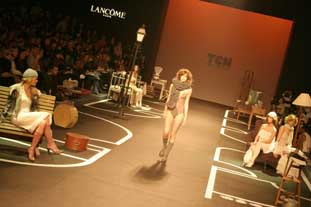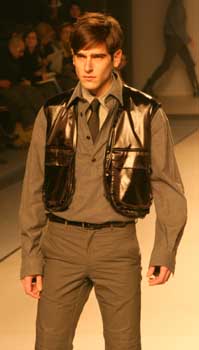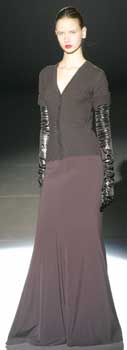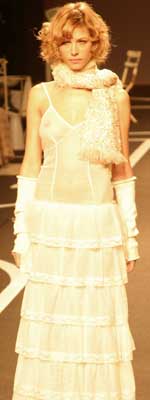|
 ARCELONA
FASHION WEEK gets larger each year. This year, it took place
at three locations, with the catwalk shows at Pasarela Gaudí.
Salon Gaudí housed the exhibitions, while several fashion
events took place at Modafat. The organizers believe 780 international
media representatives arrived in Barcelona for the week. ARCELONA
FASHION WEEK gets larger each year. This year, it took place
at three locations, with the catwalk shows at Pasarela Gaudí.
Salon Gaudí housed the exhibitions, while several fashion
events took place at Modafat. The organizers believe 780 international
media representatives arrived in Barcelona for the week.
While recent events in Spain have since cast a
shadow, they do not dim the fact that the nation has come a long
way in one generation. This richness and vibrancy must not be cast
aside by the Spanish people as the world joins them in mourning
those who perished in the terrorist attacks of 3-11. To allow merchants
of terror to change Spain would be a disservice to the memories
of those who perished; Spanish culture and freedom must always be
celebrated.
Therefore, Lucire takes readers back to
late January–early February, while we were juggling several centres’
fashion shows, to celebrate Spain and its people. Photographed specially
for Lucire by new photographer Joma García i Gisbert,
Pasarela Gaudí’s collections showed a design community sure
of where it is heading. While spring has not begun with cheerful
faces in Spain, autumn ’04 looks like a great season for Spanish
fashion.
It is unsurprising: Spain has, since the mid-1980s,
re-established itself with a strong national brand. A cultural renaissance
has emerged—an active royal family, the films of Almodovar, the
Barcelona Olympics, even the current Seat cars—all of which provide
a social context for Spanish designers. No one seems surprised nowadays
when we see ‘Made in Spain’ on fashionable, quality items. The beat-up
Renault 7 is no more.
In addition, Spain has encouraged its young talent.
There is no visible establishment, at least on our cursory glance,
that blocks their entry. Paco Flaqué, director of Moda Barcelona,
placed young people ‘above all’, understanding that they are critical
to the future of the collections. In addition, Flaqué points
to the creative designers of neighbouring Portugal, who also appeared
on the Barcelona catwalks. Predictably, Catalan designers have been favourable toward Gaudí. Finally, some top-name Madrid designers, Victorio & Lucchio, Miriam Ocáriz and Soul Aguilar show in Barcelona rather their own Pasarela Cibeles. Flaqué puts this down to the more modernist atmosphere of the Gaudí catwalks and Barcelona’s image of innovation, while cynics might say that Cibeles has become stuffy and stagnant.
Civic rivalry aside, the fashion was vibrant and
colourful, and one might wonder whether the designers were creating
for autumn–winter, a season generally associated with blacks and
browns. Most Barcelona designers threw out the rule book and decided
to innovate instead.
CONTINUED

|
    
PREVIOUS PAGE, TOP AND ABOVE RIGHT: TCN. CENTRE ROW AND ABOVE LEFT: Antonio Miró.
No one seems surprised nowadays when we see ‘Made in Spain’ on fashionable, quality items
|

